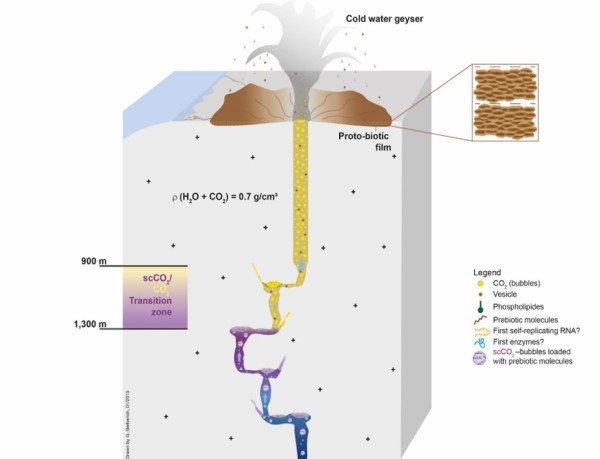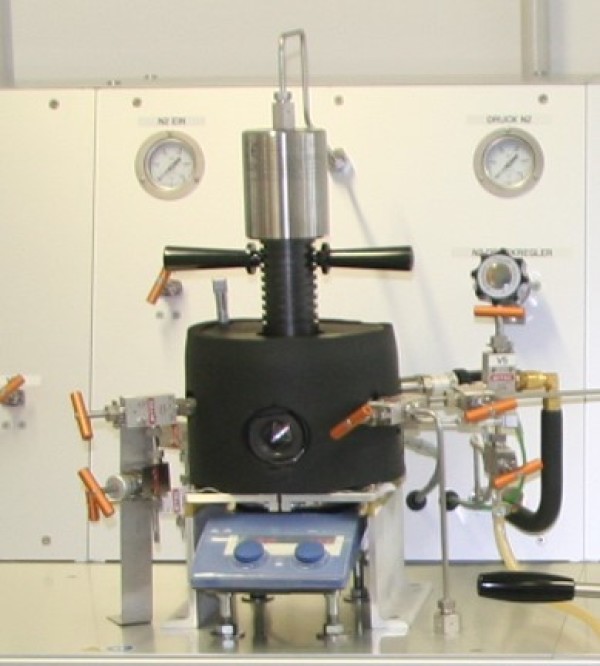Origin of Life
The origin of life is still an unsolved mystery in science. Hypothetically, prebiotic chemistry and the formation of protocells may have evolved in the hydrothermal environment of tectonic fault zones in the upper continental crust, an environment where sensitive molecules are well protected against degradation induced e.g. by UV radiation. The composition of fluid inclusions in minerals such as quartz which have grown in this environment during the Archean period might provide important information about the first organic molecules formed by hydrothermal synthesis.
Therefore, we have analysed fluid inclusions of Archean quartz minerals from Western Australia and found a selection of organic compounds such as alkanes, halocarbons, alcohols and aldehydes which unambiguously show that simple and even more complex prebiotic organic molecules have been formed by hydrothermal processes. Stable isotope analysis confirms that the methane found in the inclusions has most likely been formed from abiotic sources by hydrothermal chemistry. Obviously, the liquid phase in the continental Archean crust provided an interesting choice of functional organic molecules. We conclude that these organic substances could have made an important contribution to prebiotic chemistry which eventually might have led to the formation of the first living cell.
Tectonic fault systems in the continental crust offer huge networks of interconnected channels and cavities. Filled mainly with water and carbon dioxide (CO2), containing a wide variety of hydrothermal chemistry and numerous catalytic surfaces, they offer ideal conditions for prebiotic chemistry, molecular evolution, protocell formation and hence the origin of life. In a depth range between 1 and 7 km, the carbon dioxide will exist as a supercritical fluid forming a two phase system together with the liquid water.
The combination of carbon dioxide as a hydrophobic medium with the aqueous phase and the resulting existence of a phase boundary allows for phase transfer reactions and provides entropy gains by allowing the resulting reaction products to spread out in the corresponding medium. Within the given depth range, the reaction conditions are extremely variable in terms of pressure and temperature conditions. At a depth of approximately 1 km where CO2 turns sub-critical and dissolved components precipitate, an accumulation zone for organic compounds will develop. In addition, periodic pressure changes caused for example by tidal influences or geyser activity may generate a cyclic process involving repeated phase transitions of carbon dioxide.
In the presence of amphiphilic compounds (we have evidence for their existence due to our analyses of liquid inclusions), this will necessarily lead to the transient formation of coated water droplets in the gas phase and corresponding vesicular structures in the aqueous environment. Altogether, the two-phase hydrothermal chemistry together with the process of periodic formation and destruction of vesicles could offer a perfect environment for prebiotic chemistry and for molecular evolution in small compartments, finally leading to the generation of protocells.
Based on this new model of a possible origin of life, we establish an efficient and stable system undergoing structural reproduction, self-optimization and molecular evolution. This system is being formed by the interaction of two cyclic processes, one of which offering vesicles as the structural environment, the other supplying peptides from a variety of amino acids as versatile building blocks.
Meanwhile, we can show that structures growing in a combination of both cycles have the potential to support their own existence, to undergo chemical and structural evolution and to develop unpredicted functional properties. The key mechanism is the mutual stabilization of the peptides by the vesicles and of the vesicles by the peptides together with a constant production and selection of both. The development of the proposed system over time not only would represent one of the principles of life, but could also be a model for the formation of self-evolving structures ultimately leading to the first living cell. In addition, the process could be applied to run a controlled evolution process leading to peptides which undergo particularly strong interactions with membranes of given target cells (e.g. of the nervous tissue).
First experiments yield clear evidence on a vesicle-induced accumulation of membrane-interacting peptides which could be identified by liquid chromatography combined with high-resolution mass spectroscopy. We found that the selected peptide has an immediate effect on the vesicles, leading to i) reduced vesicle size, ii) increased vesicle membrane permeability, and iii) improved vesicle stability.



